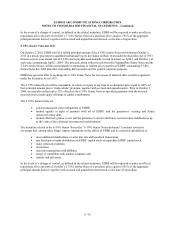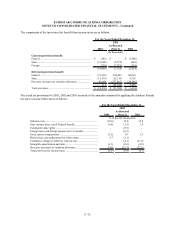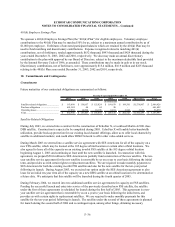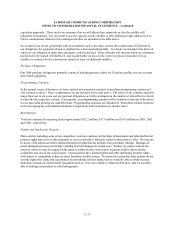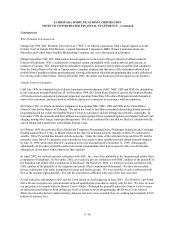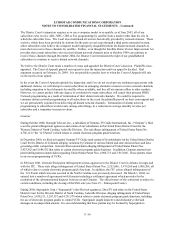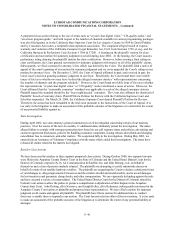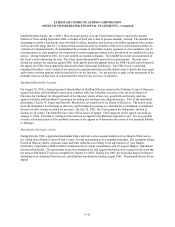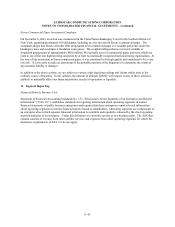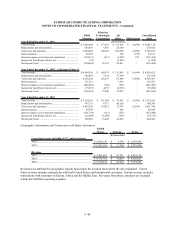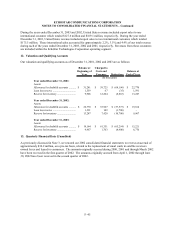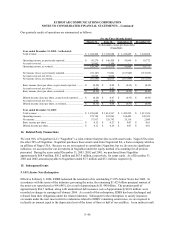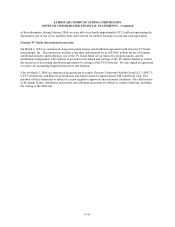Dish Network 2003 Annual Report Download - page 106
Download and view the complete annual report
Please find page 106 of the 2003 Dish Network annual report below. You can navigate through the pages in the report by either clicking on the pages listed below, or by using the keyword search tool below to find specific information within the annual report.ECHOSTAR COMMUNICATIONS CORPORATION
NOTES TO CONSOLIDATED FINANCIAL STATEMENTS – Continued
F–39
The District Court’s injunction requires us to use a computer model to re-qualify, as of June 2003, all of our
subscribers who receive ABC, NBC, CBS or Fox programming by satellite from a market other than the city in
which the subscriber lives. The Court also invalidated all waivers historically provided by network stations. These
waivers, which have been provided by stations for the past several years through a third party automated system,
allow subscribers who believe the computer model improperly disqualified them for distant network channels to
none-the-less receive those channels by satellite. Further, even though the Satellite Home Viewer Improvement Act
provides that certain subscribers who received distant network channels prior to October 1999 can continue to
receive those channels through December 2004, the District Court terminated the right of our grandfathered
subscribers to continue to receive distant network channels.
We believe the District Court made a number of errors and appealed the District Court’s decision. Plaintiffs cross-
appealed. The Court of Appeals granted our request to stay the injunction until our appeal is decided. Oral
argument occurred on February 26, 2004. It is not possible to predict how or when the Court of Appeals will rule
on the merits of our appeal.
In the event the Court of Appeals upholds the injunction, and if we do not reach private settlement agreements with
additional stations, we will attempt to assist subscribers in arranging alternative means to receive network channels,
including migration to local channels by satellite where available, and free off air antenna offers in other markets.
However, we cannot predict with any degree of certainty how many subscribers will cancel their primary DISH
Network programming as a result of termination of their distant network channels. We could be required to
terminate distant network programming to all subscribers in the event the plaintiffs prevail on their cross-appeal and
we are permanently enjoined from delivering all distant network channels. Termination of distant network
programming to subscribers would result, among other things, in a reduction in average monthly revenue per
subscriber and a temporary increase in churn.
Gemstar
During October 2000, Starsight Telecast, Inc., a subsidiary of Gemstar-TV Guide International, Inc. (“Gemstar”), filed
a suit for patent infringement against us and certain of our subsidiaries in the United States District Court for the
Western District of North Carolina, Asheville Division. The suit alleges infringement of United States Patent No.
4,706,121 (“the ‘121 Patent”) which relates to certain electronic program guide functions.
In December 2000, we filed suit against Gemstar-TV Guide (and certain of its subsidiaries) in the United States District
Court for the District of Colorado alleging violations by Gemstar of various federal and state anti-trust laws and laws
governing unfair competition. Gemstar filed counterclaims alleging infringement of United States Patent Nos.
5,923,362 and 5,684,525 that relate to certain electronic program guide functions. In addition, Gemstar asserted new
patent infringement counterclaims regarding United States Patent Nos. 4,908,713 and 5,915,068. These patents relate
to on-screen programming of VCRs.
In February 2001, Gemstar filed patent infringement actions against us in the District Court in Atlanta, Georgia and
with the ITC. These suits allege infringement of United States Patent Nos. 5,252,066, 5,479,268 and 5,809,204, all
of which relate to certain electronic program guide functions. In addition, the ITC action alleged infringement of
the ‘121 Patent which was also asserted in the North Carolina case previously discussed. On March 1, 2004, we
entered into a number of agreements with Gemstar including a settlement agreement which provides for the
resolution of the aforementioned disputes between us and Gemstar. The effectiveness of the settlement is subject to
certain conditions, including the closing of the SNG sale (see Note 15 – Subsequent Events).
During 2000, Superguide Corp. (“Superguide”) also filed suit against us, DirecTV and others in the United States
District Court for the Western District of North Carolina, Asheville Division, alleging infringement of United States
Patent Nos. 5,038,211, 5,293,357 and 4,751,578 which relate to certain electronic program guide functions, including
the use of electronic program guides to control VCRs. Superguide sought injunctive and declaratory relief and
damages in an unspecified amount. It is our understanding that these patents may be licensed by Superguide to



